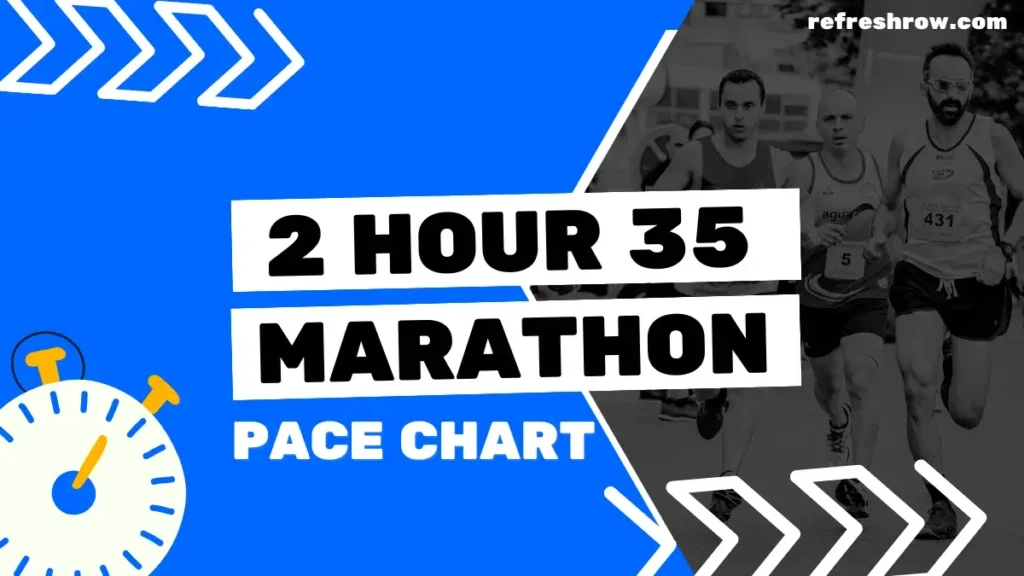To run a 6:15 hour marathon you need to run at a pace of 14:18 per mile or 8:53 per kilometer.
Following the splits below (and shaving off a second), you’ll run a sub 6:15 marathon.
I’d recommend aiming to run 1-2 minutes ahead of the split target time from 10 miles, as you’ll likely come up against crowding on race day.
6:15 Marathon Pace in Miles
| Mile | Split |
|---|---|
| 1 | 14:18 |
| 2 | 28:36 |
| 3 | 42:54 |
| 4 | 57:12 |
| 5 | 1:11:30 |
| 6 | 1:25:48 |
| 7 | 1:40:07 |
| 8 | 1:54:25 |
| 9 | 2:08:43 |
| 10 | 2:23:01 |
| 11 | 2:37:19 |
| 12 | 2:51:37 |
| 13 | 3:05:56 |
| 14 | 3:20:14 |
| 15 | 3:34:32 |
| 16 | 3:48:50 |
| 17 | 4:03:08 |
| 18 | 4:17:26 |
| 19 | 4:31:44 |
| 20 | 4:46:03 |
| 21 | 5:00:21 |
| 22 | 5:14:39 |
| 23 | 5:28:57 |
| 24 | 5:43:15 |
| 25 | 5:57:33 |
| 26 | 6:11:52 |
| 26.2 | 6:15:00 |
Download
6:15 Marathon Pace in KM
| KM | Split |
|---|---|
| 1 | 8:53 |
| 2 | 17:46 |
| 3 | 26:40 |
| 4 | 35:33 |
| 5 | 44:26 |
| 6 | 53:20 |
| 7 | 1:02:13 |
| 8 | 1:11:06 |
| 9 | 1:20:00 |
| 10 | 1:28:53 |
| 11 | 1:37:46 |
| 12 | 1:46:40 |
| 13 | 1:55:33 |
| 14 | 2:04:26 |
| 15 | 2:13:20 |
| 16 | 2:22:13 |
| 17 | 2:31:06 |
| 18 | 2:40:00 |
| 19 | 2:48:53 |
| 20 | 2:57:46 |
| 21 | 3:06:40 |
| 22 | 3:15:33 |
| 23 | 3:24:26 |
| 24 | 3:33:20 |
| 25 | 3:42:13 |
| 26 | 3:51:07 |
| 27 | 4:00:00 |
| 28 | 4:08:53 |
| 29 | 4:17:47 |
| 30 | 4:26:40 |
| 31 | 4:35:33 |
| 32 | 4:44:27 |
| 33 | 4:53:20 |
| 34 | 5:02:13 |
| 35 | 5:11:07 |
| 36 | 5:20:00 |
| 37 | 5:28:53 |
| 38 | 5:37:47 |
| 39 | 5:46:40 |
| 40 | 5:55:33 |
| 41 | 6:04:27 |
| 42 | 6:13:20 |
| 42.2 | 6:15:04 |
Download
Other Marathon Pace Charts
Targeting a different time?
Check out the Full Marathon Pace Chart in Miles or KM
Or select a specific finishing time below:
| 3:00 | 4:00 | 5:00 | |
| 3:05 | 4:05 | 5:15 | |
| 3:10 | 4:10 | 5:30 | |
| 3:15 | 4:15 | 5:45 | |
| 3:20 | 4:20 | 6:00 | |
| 3:25 | 4:25 | 6:15 | |
| 2:30 | 3:30 | 4:30 | 6:30 |
| 2:35 | 3:35 | 4:35 | 6:45 |
| 2:40 | 3:40 | 4:40 | 7:00 |
| 2:45 | 3:45 | 4:45 | |
| 2:50 | 3:50 | 4:50 | |
| 2:55 | 3:55 | 4:55 |
Training for a 6:15 Marathon
Is 6:15 a Good Marathon Time?
Well, what do the stats say?
Run Repeat conducted a study that contains 19,614,975 marathon results from more than 32,335 races across the globe, here is how a 6:15 marathon compares against age and gender for the races recorded:
| Overall | You’re faster than 4.5% of all runners. |
| Male | You’re faster than 3.0% of males. |
| Female | You’re faster than 6.4% of females. |
| <20 | You’re faster than 6.3% of under 20s. |
| 20-29 | You’re faster than 2.7% of 20-29 year olds. |
| 30-39 | You’re faster than 2.6% of 30-39 year olds. |
| 40-49 | You’re faster than 3.3% of 40-49 year olds. |
| 50-59 | You’re faster than 5.8% of 50-59 year olds. |
| >60 | You’re faster than 14.4% of over 60s. |
Training Runs and Paces for a 6:15 Marathon
To break a 6:15 marathon you’ll need to do some serious distance in your training, I recommend at least 10 miles (16km) per week.
You’re also going to need to make sure you’ve crossed off these milestones for other race distances:
- A 5k in 39:05
- A 10k in 1:21:40
- A half marathon in 2:51:00
Training Paces
| Pace | Mins per Mile | Mins per KM |
|---|---|---|
| Easy | 16:07 | 10:01 |
| Steady | 14:18 | 8:53 |
| 10k | 13:07 | 8:09 |
| 5k | 12:35 | 7:49 |
| 1 Mile | 11:41 | 7:18 |
Weekly Mileage Targets
| Target Mileage: | Gradually increase your weekly mileage from 6 miles (10 km) to a peak of 12 miles (19 km). |
| Incremental Increase: | Increase mileage by approximately 10% each week, with every fourth week as a recovery week where mileage is reduced by 20-30%. Make sure to taper for the last 1-2 weeks. |
Long Run Structure
| Total Distance: | Build up to long runs of 8-10 miles (13-16 km). |
| Segment Example: | First 3 miles (5 km): Easy pace, heart rate 140-150 bpm (approximately 17:15/mile or 10:43/km). Next 1 mile (1.6 km): Fast pace at 11:45/mile (7:18/km). Next 3 miles (5 km): Medium effort, heart rate around 160 bpm (approximately 12:50/mile or 7:58/km). Final 3 miles (5 km): Easy pace again at 17:15/mile (10:43/km). |
Why This Works: This structure trains your body to handle different paces and efforts while fatigued, helping you develop endurance and mental toughness. The variation between easy, fast, and medium paces replicates the conditions of a marathon and builds your stamina for race day.
Alternating Long Runs: Alternate between structured long runs (with pace variations) and easier, steady long runs focused solely on building mileage and aiding recovery.
Speedwork Sessions
| Short Intervals: | – 400m repeats at 5:40 per interval (7:03/km). – Aim for 3-5 repetitions with equal time for recovery. |
| Mile Repeats: | – 1 mile repeats at 11:45 per mile (7:18/km). – Aim for 2-3 repetitions with a 1-2 minute recovery jog. |
| Longer Intervals: | – 2 mile repeats at 12:00 per mile (7:27/km). – Aim for 2-3 repetitions with a 2-3 minute recovery jog. |
Recovery and Rest Days
| Rest Days: | Include 1-2 rest days per week to ensure full recovery and prevent overtraining. |
| Easy Run Days: | Include 1-2 easy run days per week at a relaxed pace of 17:30/mile (10:52/km), covering 2-3 miles (3-5 km) per day. Try to keep your heart rate below 140 bpm on easy days to ensure proper recovery and aerobic development. |
My Tips to Run a Sub 6:15 Marathon
Get Comfortable with Fatigue and Discomfort
It’s more likely than not that you’ll face some physical and mental discomfort in the later stages of the race.
How do you prepare for this?
In your training runs, take yourself beyond your comfort zone, even if that means walking the last few miles.
Learn to embrace the fatigue and develop strategies to manage it, such as deep breathing or focusing on small landmarks ahead.
You know the tiredness is going to come, so plan mantras or mental techniques to keep yourself moving forward when it hits.
Incorporate Multi-Modal Cross-Training
Running long distances at a slower pace can sometimes lead to repetitive stress injuries.
(6 hours is a long time to be running)
To counteract this, consider adding low-impact cross-training like swimming, cycling, or using an elliptical machine to your routine.
These activities allow you to build cardiovascular endurance and muscular strength without putting too much strain on your joints.
I’d aim for one to two cross-training sessions per week.
It’s a great way to give your legs a break from pounding the pavement while still progressing toward your marathon goal.
Plan Your Recovery Stops Ahead of Time
You might find that you need to stop during your marathon.
Don’t let this get you down.
Think of them as “strategic recovery stops”.
During your training runs, practice taking short breaks where you stretch, hydrate, or refuel, and then quickly get back to moving.
This will prevent your body from stiffening up and losing momentum.
On race day, plan your stops at water stations or designated rest points, ensuring that they don’t last too long.
Practicing these breaks during your long runs will teach your body how to recover quickly, preventing a major slowdown late in the race.
Break the Marathon Into Manageable Segments
Instead of viewing the race as a daunting 26.2 miles, mentally break it down into smaller, manageable segments.
In your training, try dividing your long runs into 5-mile or 10-kilometer blocks, and treat each segment as its own mini-goal.
You can even assign a different focus to each segment, like form or breathing.
This approach will make the distance seem less overwhelming and help you stay motivated as you complete each chunk of the race.
The key is to take it one step at a time, celebrating small victories along the way.
YOU CAN DO THIS!


Row Brown is the founder of Refresh Row. He is a keen marathon runner, his favorite being the London Marathon. He’s now set himself the mission of Running the Entire Length of Spain, which is scheduled for late 2024.


